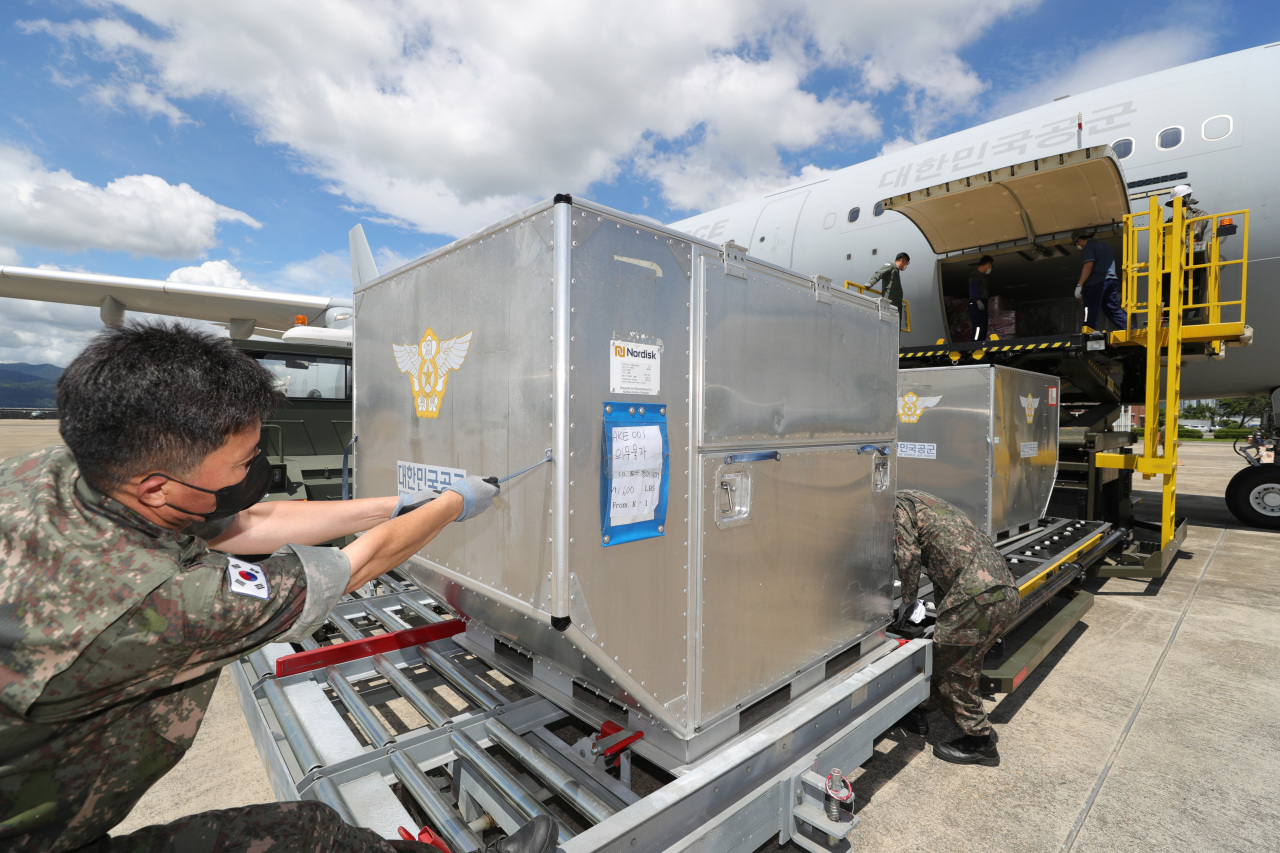
Soldiers load medical supplies onto an aerial tanker ahead of its mission to airlift an anti-piracy unit aboard a COVID-hit destroyer near Africa on July 18. (Ministry of National Defense)
The military has recently seen its biggest coronavirus outbreak since the pandemic began, which forced its anti-piracy warship to come home last week. The 301-strong Cheonghae Unit, which left the country unvaccinated for Africa in February, cut short its mission because more than two-thirds of its crew were infected.
But the military, which sent an aircraft to airlift the crew and a contingent to bring the 4,400-ton destroyer left behind back home, told the parliamentary defense committee that the overseas mission had successfully completed its mission, with the defense minister saying, “We could have done better.”
Here are key takeaways from whether that is indeed an accurate description of what happened.
Omitted from vaccination
The 301 seamen were found to have been omitted from the vaccine priority list in February because of supply constraints. And they were overlooked again in June, when the military expanded its vaccination campaign with US-provided Johnson & Johnson vaccines.
The military said the reason was that the seamen could not handle a possible allergic reaction to the vaccine or manage the extreme storage conditions needed for the vaccine onboard. Critics have said the military could have enlisted help from the nearby US Navy or from local authorities.
But the military had not consulted either the UN or local authorities for vaccines, according to Rep. Han Ki-ho, a main opposition People Power Party lawmaker who sits on the defense committee. He referred to the latest committee briefings done by the Ministry of National Defense.
That finding contradicts what Defense Minister Suh Wook said in February, when he told the committee that the military was looking to discuss vaccination with local authorities.
“Aside from all the outside help, we could have flown vaccines and medical staff to the seamen. They were just airlifted from Africa and I think it could and should work the other way around,” said Shin Jong-woo, a senior analyst at the Korea Defense and Security Forum. “Why didn’t we?”
On Monday, Suh said that the military had asked for help from the Omani government, which he said refused either to give its COVID-19 shots to the Korean seamen or to have Korean authorities vaccinate the seamen on its soil. A Korean defense attache contacted the local authorities in Oman.
But the Ministry of Foreign Affairs, which works to facilitate such requests, said it was not made aware of the call because the military had rather informally asked the Omani government.
“This barely amounts to an ‘official request,’ which is what we need for vaccines to happen. We need someone senior making that call, like the minister himself,” a Seoul official said on the condition of anonymity.
Wrong diagnosis and toolA seaman first exhibited cold-like symptoms on July 2, a day after the destroyer had made a four-day supply stop at a port. But he was treated with cold medicine and not tested for COVID-19, even though many others began to show similar symptoms.
The two military doctors onboard the ship -- a surgeon and an anesthetist -- had allegedly overlooked COVID-19 symptoms. They said they had consulted doctors here who know how to handle COVID-19 through a videoconference.
Meanwhile, the inadequate self-test kits Cheonghae had packed upon leaving Korea aggravated the situation. The unit ran all “cold” samples on antibody test kits, which take much longer to detect infection than antigen test kits that the military had prepared in advance for the overseas mission.
“We just dropped the ball there,” a military official said.
A Cheonghae officer recounted the military’s response to the growing outbreak aboard the vessel had been disappointing as the 301 seamen fought to curb the infection.
“It was days later when we brought in local medical specialists to administer the industry-standard PCR tests,” he said, adding strict quarantine procedures only took place after the first six COVID-19 patients were found.
That confirmation came on July 15, and three days later, the military flew two aerial tankers to bring back the entire crew home. Many service members who had tested negative for COVID-19 using self-test kits were believed to have been infected.
Of 301 crew members, 272 have so far tested positive for COVID-19, with 17 hospitalized. Those who have tested negative -- 29 in total -- are in quarantine until the incubation period runs out.
Tracing worst outbreakA military-led inspection, triggered by public uproar demanding the defense minister resign to take responsibility, is looking for missteps that forced the COVID-19-hit ship to return home.
Seamen said that the coronavirus could have spread onto the vessel from food supplies they loaded from the port, saying, “The supplies were not properly sealed.” They said cooks were among the first to show symptoms, and that raises a strong suspicion.
But health authorities were wary of pinning the blame on the food supplies, with one official saying, “It’s all still a working theory, one of many that has yet to pan out.”
Dr. Kim Woo-joo of Korea University, who specializes in infectious diseases, agrees.
“People-to-people contact is most likely and I think the service members could have a hard time recalling everything that was suspicious back there,” he said, adding it was possible for the seamen to selectively remember what had happened out in the sea, either willingly or unwillingly because of peer pressure.
But the massive outbreak was preventable because there were opportunities along the way, which no one seemed to have cared enough to pursue, Kim said.






